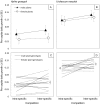The tri-trophic interactions hypothesis: interactive effects of host plant quality, diet breadth and natural enemies on herbivores
- PMID: 22509298
- PMCID: PMC3324533
- DOI: 10.1371/journal.pone.0034403
The tri-trophic interactions hypothesis: interactive effects of host plant quality, diet breadth and natural enemies on herbivores
Abstract
Several influential hypotheses in plant-herbivore and herbivore-predator interactions consider the interactive effects of plant quality, herbivore diet breadth, and predation on herbivore performance. Yet individually and collectively, these hypotheses fail to address the simultaneous influence of all three factors. Here we review existing hypotheses, and propose the tri-trophic interactions (TTI) hypothesis to consolidate and integrate their predictions. The TTI hypothesis predicts that dietary specialist herbivores (as compared to generalists) should escape predators and be competitively dominant due to faster growth rates, and that such differences should be greater on low quality (as compared to high quality) host plants. To provide a preliminary test of these predictions, we conducted an empirical study comparing the effects of plant (Baccharis salicifolia) quality and predators between a specialist (Uroleucon macolai) and a generalist (Aphis gossypii) aphid herbivore. Consistent with predictions, these three factors interactively determine herbivore performance in ways not addressed by existing hypotheses. Compared to the specialist, the generalist was less fecund, competitively inferior, and more sensitive to low plant quality. Correspondingly, predator effects were contingent upon plant quality only for the generalist. Contrary to predictions, predator effects were weaker for the generalist and on low-quality plants, likely due to density-dependent benefits provided to the generalist by mutualist ants. Because the TTI hypothesis predicts the superior performance of specialists, mutualist ants may be critical to A. gossypii persistence under competition from U. macolai. In summary, the integrative nature of the TTI hypothesis offers novel insight into the determinants of plant-herbivore and herbivore-predator interactions and the coexistence of specialist and generalist herbivores.
Conflict of interest statement
Figures




References
-
- Dethier VG. Evolution of feeding preference in phytophagous insects. Evolution. 1954;8:33–54.
-
- Fraenkel GS. Raison d'etre of seconary plant substances. Science. 1959;129:1466–1470. - PubMed
-
- Ehrlich PR, Raven PH. Butterflies and plants: A study in coevolution. Evolution. 1964;18:586–608.
-
- Feeny PP. Plant apparency and chemical defense. Recent Advances in Phytochemistry. 1976;10:1–40.
-
- Rhoades DF, Cates RG. Toward a general theory of plant antiherbivore chemistry. Recent Advances in Phytochemistry. 1976;10:168–213.

